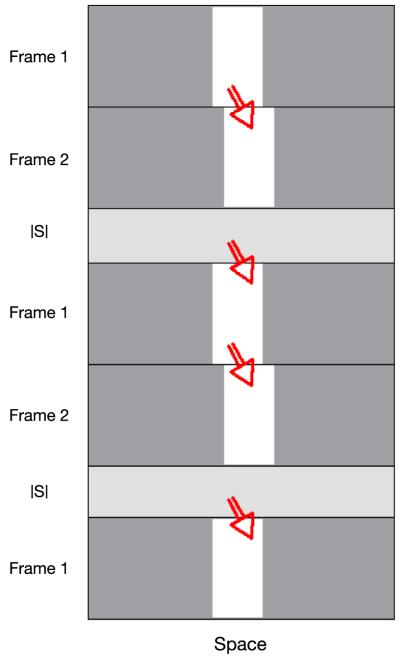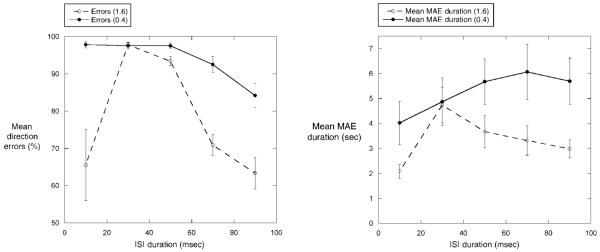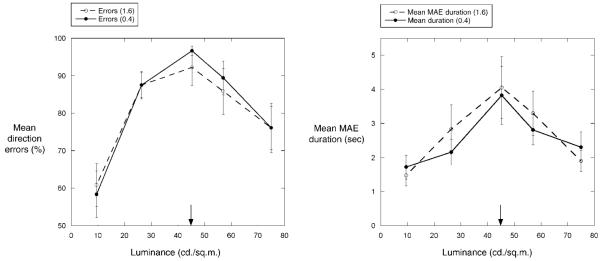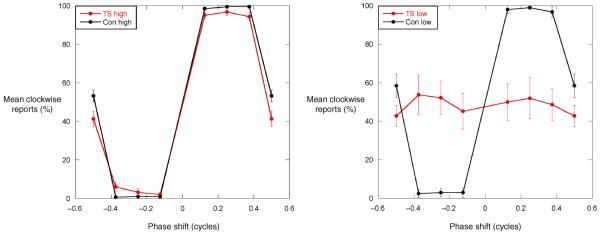Abstract
In two-stroke apparent movement, repeated presentation of a two-frame pattern displacement followed by a brief inter-stimulus interval (ISI) can create an impression of continuous forward motion (G. Mather, 2006). Does the ISI in two-stroke motion just break the connection between adjacent frames, switching off the motion signal they normally generate, or does it actually generate a reversed motion signal? Reversed apparent motion in two-frame stimuli separated by a brief ISI has been reported in several previous papers (ISI reversal), which found that the effect is optimal at short, mean-luminance ISIs, and is abolished at scotopic luminances. A series of five experiments compared two-stroke apparent motion with ISI reversal using the same stimulus display. The two effects show the same dependence on ISI duration and luminance and are both abolished at low mean luminance. Results therefore support the conclusion that the ISI in two-stroke apparent motion does contribute a reversed motion signal and constrain theoretical explanations of two-stroke apparent motion.
Keywords: apparent motion, temporal response, two-stroke apparent motion
Introduction
In ‘two-stroke’ apparent motion, repeated presentation of a two-frame pattern displacement can create an impression of continuous forward motion when an inter-stimulus interval (ISI) is inserted at one of the frame transitions. Figure 1 shows two pattern frames presented in an alternating sequence that would usually create an impression of to-and-fro motion. The presence of a blank ISI at one of the two frame transitions creates apparently unidirectional motion (see Mather, 2006). The illusion is related to an effect previously observed in two-frame direction discrimination experiments: when a brief blank ISI is inserted between the two frames discrimination performance dips significantly below chance levels (see Shioiri & Cavanagh, 1990; Strout, Pantle, & Mills, 1994; Takeuchi & De Valois, 1997). Previous authors have attributed this ‘ISI reversal’ to the biphasic temporal impulse response of the visual filters, which precede standard motion energy sensors (Adelson & Bergen, 1985). Some describe it as creating a contrast-reversed neural image, and it is known that reversals of contrast cause reversals in apparent motion (Anstis, 1970; Anstis & Rogers, 1975, 1986).
Figure 1.
Two-stroke apparent motion sequence. Two pattern frames (Frame 1, Frame 2) are presented repeatedly; an inter-stimulus interval (ISI) intervenes at one of the two frame transitions. The Frame 1–Frame 2 transition in this example should generate a rightward motion signal in the visual system (arrows). The Frame 2–Frame 1 transition would normally generate a leftward motion signal, but it is argued that the effect of the ISI is to reverse this signal, so the sequence appears uni-directionally rightward. Note that experimental stimuli were gratings containing both light and dark bars, rather than the light bars illustrated.
The relation between two-stroke apparent motion and ISI reversal remains to be clarified and is critical for an explanation of two-stroke apparent motion. It could be argued that the ISI plays different roles in the two effects: the ISI in the two-stroke sequence may serve only to break the link between the preceding and succeeding frames, which would otherwise signal backward motion in the sequence. According to this view the only forward signal in the two-stroke sequence is carried by the frame transition that does not include an ISI. If this were the case, then manipulations that are known to abolish ISI reversal should have little or no effect on the two-stroke illusion. This paper describes a series of experiments aimed at testing the empirical correspondence between two-stroke motion and ISI reversal motion, so that theoretical explanations can be developed and tested from a firm empirical base.
Experiments 1 and 2
Previous studies have reported that ISI reversal occurs only at brief ISIs of approximately 40 msec (Sheliga, Chen, FitzGibbon, & Miles, 2006; Shioiri & Cavanagh, 1990; Strout et al., 1994; Takeuchi & De Valois, 1997). In Experiment 1 we attempted to replicate this effect on direction discrimination in a two-frame display. We compared these results to those of Experiment 2, which used the same display to measure the effect of ISI duration on the strength of two-stroke apparent motion. The duration of the motion after-effect (MAE) was used as a convenient measure of the strength of unidirectional motion seen in the two-stroke effect because it is well established as a tool for assessing responses in low-level motion sensors (see review in Mather, Verstraten, & Anstis, 1998). If the ISI in two-stroke motion generates a reversed motion signal comparable to that seen in two-frame direction experiments, then we should obtain the same ISI dependence in the two experiments.
Experiments 3 and 4
Previous experiments on ISI reversal have shown that the luminance of the ISI is crucial for the occurrence of errors in direction discrimination, with most errors occurring when a mean luminance ISI is used. Experiments 3 and 4 tested for an effect of ISI luminance using the same direction discrimination and MAE tasks as used in the first two experiments.
Experiment 5
Takeuchi and De Valois (1997) obtained ISI reversal in a two-frame direction discrimination task only when the stimulus was presented at photopic luminances. The effect was abolished at scotopic luminances. They attributed this abolition to the fact that ISI reversal occurs only when the input filters to motion sensors have a biphasic temporal response. The temporal response of the human visual system is well known to become monophasic at low luminances (e.g., Kelly, 1971). To assess the plausibility of this account as an explanation for two-stroke apparent motion, Experiment 5 tested whether two-stroke apparent motion is abolished using stimuli with a low mean luminance. While the MAE is well established as a tool for assessing low-level motion responses, it is less than ideal for collecting a large volume of data due to the relatively slow rate at which data accumulates. We therefore developed new measure of two-stroke apparent motion, based on a multi-frame direction discrimination task.
Figure 2 (top) illustrates the two-stroke stimulus. It contains seven animation frames conforming to the two-stroke sequence. The frame-to-frame to-and-fro rotation of the bar should give an impression of continuous clockwise rotation, due to the reversal effect of the ISI in the second and fifth animation frames. Note that if there is no two-stroke effect, the display in Figure 2 (top) should be ambiguous because it contains two clockwise (CW) steps and two counterclockwise (CCW) steps. The lower animation sequence in Figure 2 depicts a control stimulus containing standard apparent motion (no ISIs), which rotates unambiguously CW in four steps.
Figure 2.

Multi-frame stimuli used in Experiment 5. Time advances from left to right, and each rectangle represents an animation frame. Top: Two-stroke display containing seven animation frames. The bar in each frame rotates from one frame to the next; CW rotations occur without a blank ISI, while CCW rotations occur with an intervening ISI. Bottom: Corresponding control display containing five animation frames, which contains the same number of position changes but without intervening ISIs.
In a physical sense the displays in Figure 2 are actually ambiguous because they could be described in terms of either a CW rotation (e.g., 1/4 of a cycle) or a CCW rotation (e.g., 3/4 of a cycle). Previous research (Nakayama & Silverman, 1985) has shown that psychophysical performance is dominated by the direction corresponding to the shortest path. In Experiment 5 we parametrically varied the magnitude of the frame-to-frame rotation (phase shift) in both two-stroke and control displays to determine whether the two stimuli show the same dependence on phase shift. At high mean luminance, we predict that both displays will appear to move consistently in the direction of the shortest displacement. At low mean luminance we predict chance performance for the two-stroke stimulus but normal performance for the control stimulus.
Methods
General apparatus
Stimuli were generated by a Dell PC equipped with a CRS VSG2/5 graphics system, using Matlab scripts, and displayed on a Sony Trinitron G400 monitor (refresh rate 100 Hz). Viewing distance was 114 cm.
Experiments 1 and 2
Subjects
Nine naive observers participated in each experiment.
Stimuli
Stimuli were presented as radial gratings in an annulus. The diameter to the middle of annulus was 6.4 deg, annulus width was 2.1 deg, with a centrally located fixation spot.
Animation sequences are illustrated schematically in Figure 2. The total duration of the two-stroke animation sequence was 280 msec (using 40 msec frame durations, FDs, and 40 msec ISIs), during which the bar took four animation steps. The total duration of the control sequence was 300 msec (using 60 msec FDs).
Two spatial frequencies were used in different sessions: 0.4 cpd and 1.6 cpd, expressed as the equivalent linear frequency (i.e., unwrapping the annulus; there were 8 or 32 cycles visible in the annulus at the two frequencies, respectively). Annular gratings have two advantages. First, they offer a spatially extended stimulus, which avoids complications due to retinal inhomogeneity in receptive field properties. Second, they avoid the tendency for subjects to track elements in a centrally fixated drifting grating. Mean luminance was 45.3 cd/sq.m. Contrast was 0.49.
Procedure for Experiment 1 (direction discrimination)
In each two-frame presentation (FD 300 msec) the grating displaced either CW or CCW (pseudo-randomly selected) by 90 deg of phase between frames. Following each presentation the observer pressed one of two keys to indicate apparent direction. The luminance of the ISI between the frames was fixed at the mean luminance of the grating. Each subject received forty trials at each of five possible ISIs for each spatial frequency, selected pseudo-randomly from trial to trial: 10, 30, 50, 70, and 90 msec. Different spatial frequencies were run in different experimental sessions. Movie 1 contains a demonstration of a single experimental trial: the grating rotates CCW between frames but may appear to rotate CW (track an individual bar to confirm direction).
Procedure for Experiment 2 (MAE duration)
The annular grating was presented repetitively as a two-stroke motion sequence for 30 sec. Each pattern frame lasted 10 msec; the grating rotated either CW or CCW by 90 deg of phase between frames to create apparent motion. As in Experiment 1, ISI luminance was fixed at mean luminance. Following adaptation the grating became static, and the observer pressed a key to indicate the duration of the MAE. The same set of five possible ISIs was employed as in Experiment 1, in different trials; results are based on six repetitions in each condition for each subject. An interval of 30 sec separated successive MAE measurements; adapting direction reversed in successive measurements. Movie 2 contains a demonstration of a two-stroke adapting stimulus: run the movie for 10 seconds, and then click the pause button to stop the animation and check for an after-effect (you may need to try this a couple of times if the pause happens to occur during the ISI).
Experiments 3 and 4
All methodological details were the same as in Experiments 1 and 2, with the following exceptions. First, a different set of naive observers was recruited. Second, ISI duration was fixed at 30 msec. Third, five different ISI luminances were used in different trials, straddling the mean luminance of the grating (pseudo-randomly selected from trial to trial): 9.5, 26.4, 45.3, 57, and 75 cd/sq.m.
Experiment 5
All details correspond to those given for previous experiments, with the following exceptions.
Subjects
Ten observers took part in the experiment, nine of whom were naive as to its purpose and had not taken part in previous experiments.
Apparatus and stimuli
The annular grating (0.4 cpd) was presented in a multiframe display as illustrated schematically in Figure 2 (actual stimuli were gratings). In the two-stroke stimulus, frame duration was 40 msec and ISI duration was 40 msec; in the control stimulus frame duration was 60 msec (frame duration was longer for the control stimulus to compensate for the lack of an ISI; the stimulus underwent the same number of displacements as the two-stroke stimulus, over the same time period). Frame-to-frame displacement in any one presentation was selected from seven possible values: −0.375, −0.25, −0.125, 0.125, 0.25, 0.375, and 0.5 cycles, where negative values refer to CCW shifts and positive values refer to CW shifts. Stimuli presented at a photopic level had a mean luminance of 45.3 cd/sq.m. Low mean luminance was created by having the subject view the same stimulus while wearing spectacles fitted with 2 log-unit neutral density filters, which reduced stimulus luminance by a factor of 100 (0.453 cd/sq.m.).
Procedure
Two-stroke and control stimuli were presented in separate sessions, making a total of four experimental sessions (two with and two without the attenuating filters). Within an experimental session each of seven possible displacements was presented 40 times in pseudo-random order. After each presentation of the 5-frame or 7-frame sequence illustrated in Figure 2 the subject pressed a response button to report the apparent direction of the stimulus. The order of the four sessions was randomized across subjects. Prior to sessions involving the attenuating filters the subject was dark adapted for 20 min.
Results and discussion
Experiments 1 and 2
Figure 3 shows results of both experiments, presented as group means ± 1 SE. For the higher spatial frequency (open symbols), both direction discrimination errors and MAE duration peak at an ISI of 30 msec and decline for shorter and longer ISIs. For the lower spatial frequency (filled symbols) errors decline above 50 msec; MAE duration peaks at 70 msec.
Figure 3.
Results of Experiment 1 (left) on direction discrimination and Experiment 2 (right) on MAE duration as a function of ISI duration. Filled symbols represent results using a grating frequency of 0.4 cpd, and open symbols show results using a grating frequency of 1.6 cpd. Discrimination results are plotted as the mean number of response errors at each ISI duration, ±1 SE. Chance performance is 50%. MAE results are plotted in terms of mean MAE duration (in sec) at each ISI duration, ±1 SE.
The similarity between the two-frame direction discrimination results and the two-stroke adaptation results supports the claim that the ISI in two-stroke motion does generate a motion signal of its own, rather than acts simply to corrupt the forward motion signal that would normally occur. The differences between results at 0.4 and 1.6 cpd indicate that the underlying filters may have non-separable spatial and temporal properties.
Experiments 3 and 4
Figure 4 shows the results of Experiments 3 and 4, using the same conventions as Figure 3. Both direction discrimination errors and MAE duration peak at the mean luminance of the grating frames and decline at lower and higher luminances. Direction discrimination data are again consistent with previous research, and the similarity with the MAE data indicates that reversed signals are generated by the ISI in two-stroke apparent motion.
Figure 4.
Results of Experiment 3 (left) on direction discrimination and Experiment 4 (right) on MAE duration as a function of ISI luminance. Arrows mark the mean luminance of the grating frames. Other conventions as in Figure 2.
Experiment 5
Figure 5 (left) shows the effect of phase shift on mean direction reports using the control stimulus (Con) and two-stroke stimulus (TS) at high luminance. Results from the two stimuli are indistinguishable. Direction reports were dominated by the shortest path: all negative phase shifts were seen as moving CCW, and all positive phase shifts were seen as moving CW. Phase shifts of 0.5 were ambiguous. Figure 5 (right) shows corresponding results at low luminance. Results for the control stimulus were very similar to those shown at high luminance, with apparent direction dependent on the sign of the phase shift. Performance using the two-stroke stimulus collapsed completely at low luminance, with no consistent direction reported at any phase shift.
Figure 5.
Results of Experiment 5, showing mean reports of clockwise apparent motion as a function of frame-to-frame phase shift, for the two-stroke (TS) and control (Con) stimuli shown in Figure 2. In negative phase shifts the direction of the shortest displacement is CCW; in positive phase shifts the direction of the shortest displacement is CW. Data at a phase shift of 0.5 are plotted twice, at the +0.5 and −0.5 positions. Left: Results at high luminance. Right: results at low luminance.
A three-way ANOVA (using Greenhouse–Geisser corrections) found no significant main effect of stimulus type [F(1,9) = 1.882, p = 0.203] or luminance [F(1,9) = 0.921, p = 0.362] but a significant main effect of phase [F(1.297,11.676) = 156.421, p < 0.001]. As predicted there was a significant interaction between luminance level, stimulus type, and phase [F(1.378, 12.402) = 22.973, p < 0.001].
The results of this experiment confirmed both predictions: (i) apparent direction is governed by the smallest phase shift in both control stimuli and two-stroke stimuli; (ii) apparent motion in two-stroke stimuli collapses at low mean luminance.
General discussion
Data from a series of five experiments supports the conclusion that the uni-directional apparent motion seen in two-stroke stimuli is due to (i) forward signals generated by transitions between pattern frames, which are not interrupted by an ISI, and (ii) reversed signals generated by transitions, which are interrupted by an ISI. The reversed signal is sensitive to ISI duration and luminance, and to overall mean luminance; two-stroke apparent motion is optimal using mean luminance ISIs of about 30 msec and is abolished at very low luminance.
Previous studies of ISI-reversal motion (Strout et al., 1994; Takeuchi & De Valois, 1997) have attempted to explain the effect in terms of the biphasic temporal response of input filters to motion energy sensors. Two-stroke apparent motion shares many of its empirical properties with ISI-reversal motion, so it should be amenable to the same explanation. Computational modeling is underway in our laboratory to establish whether the steady-state response of motion energy sensors to continuous presentation of the two-stroke sequence is consistent with the empirical data reported in this paper.
A limitation of the present experiments is that they do not use the same psychophysical measurements to examine two-frame ISI reversals and two-stroke displays. We are currently developing multi-frame stimuli, which allow the different effects to be compared, in order to rectify this limitation.
Acknowledgments
This work was supported by the Wellcome Trust [WT082816MA]. We are grateful to Andrea Pavan, Craig Hedge, Victoria Snell, and Robert Wright for assistance with data collection. Preliminary reports of parts of these data were presented at the Vision Sciences Society Annual Meeting, 2006, and at the European Conference on Visual Perception, 2007.
Footnotes
Citation: Mather, G., & Challinor, K. L. (2009). Psychophysical properties of two-stroke apparent motion. Journal of Vision, 9(1):28, 1–6, http://journalofvision.org/9/1/28/, doi:10.1167/9.1.28.
Commercial relationships: none.
References
- Adelson EH, Bergen JR. Spatiotemporal energy models for the perception of motion. Journal of the Optical Society of America A, Optics and Image Science. 1985;2:284–299. doi: 10.1364/josaa.2.000284. PubMed. [DOI] [PubMed] [Google Scholar]
- Anstis SM. Phi movement as a subtraction process. Vision Research. 1970;10:1411–1430. doi: 10.1016/0042-6989(70)90092-1. PubMed. [DOI] [PubMed] [Google Scholar]
- Anstis SM, Rogers BJ. Illusory reversal of visual depth and movement during changes of contrast. Vision Research. 1975;15:957–961. doi: 10.1016/0042-6989(75)90236-9. PubMed. [DOI] [PubMed] [Google Scholar]
- Anstis SM, Rogers BJ. Illusory continuous motion from oscillating positive–negative patterns: Implications for motion perception. Perception. 1986;15:627–640. doi: 10.1068/p150627. PubMed. [DOI] [PubMed] [Google Scholar]
- Kelly DH. Theory of flicker and transient responses. I. Uniform fields. Journal of the Optical Society of America. 1971;61:537–546. doi: 10.1364/josa.61.000537. PubMed. [DOI] [PubMed] [Google Scholar]
- Mather G. Two-stroke: A new illusion of visual motion based on the time course of neural responses in the human visual system. Vision Research. 2006;46:2015–2018. doi: 10.1016/j.visres.2005.12.022. PubMed. [DOI] [PubMed] [Google Scholar]
- Mather G, Verstraten F, Anstis S, editors. The motion after-effect: A modern perspective. MIT Press; Cambridge, MA: 1998. [Google Scholar]
- Nakayama K, Silverman GH. Detection and discrimination of sinusoidal grating displacements. Journal of the Optical Society of America A, Optics and Image Science. 1985;2:267–274. doi: 10.1364/josaa.2.000267. PubMed. [DOI] [PubMed] [Google Scholar]
- Sheliga BM, Chen KJ, FitzGibbon EJ, Miles FA. The initial ocular following responses elicited by apparent-motion stimuli: Reversal by inter-stimulus intervals. Vision Research. 2006;46:979–992. doi: 10.1016/j.visres.2005.09.001. [PubMed] [Article] [DOI] [PMC free article] [PubMed] [Google Scholar]
- Shioiri S, Cavanagh P. ISI produces reverse apparent motion. Vision Research. 1990;30:757–768. doi: 10.1016/0042-6989(90)90101-p. PubMed. [DOI] [PubMed] [Google Scholar]
- Strout JJ, Pantle A, Mills SL. An energy model of interframe interval effects in single-step apparent motion. Vision Research. 1994;34:3223–3240. doi: 10.1016/0042-6989(94)90086-8. PubMed. [DOI] [PubMed] [Google Scholar]
- Takeuchi T, De Valois KK. Motion-reversal reveals two motion mechanisms functioning in scotopic vision. Vision Research. 1997;37:745–755. doi: 10.1016/s0042-6989(96)00207-6. PubMed. [DOI] [PubMed] [Google Scholar]






